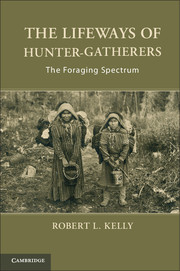Book contents
- Frontmatter
- Contents
- Tables
- Figures
- Preface
- Acknowledgments
- One Hunter-Gatherers and Anthropology
- Two Environment, Evolution, and Anthropological Theory
- Three Foraging and Subsistence
- Four Mobility
- Five Technology
- Six Sharing, Exchange, and Land Tenure
- Seven Group Size and Demography
- Eight Men, Women, and Foraging
- Nine Nonegalitarian Hunter-Gatherers
- Ten Hunter-Gatherers and Prehistory
- Notes
- References
- Index
Seven - Group Size and Demography
Published online by Cambridge University Press: 05 April 2013
- Frontmatter
- Contents
- Tables
- Figures
- Preface
- Acknowledgments
- One Hunter-Gatherers and Anthropology
- Two Environment, Evolution, and Anthropological Theory
- Three Foraging and Subsistence
- Four Mobility
- Five Technology
- Six Sharing, Exchange, and Land Tenure
- Seven Group Size and Demography
- Eight Men, Women, and Foraging
- Nine Nonegalitarian Hunter-Gatherers
- Ten Hunter-Gatherers and Prehistory
- Notes
- References
- Index
Summary
A woman who gives birth like an animal to one offspring after another has a permanent backache.
Ju/’hoan saying (Lee 1980: 325)A Dreamtime man died…no one knows why…and Wirlara the Moon-man, who was traveling with his large pack of dingoes, found the body and decided to try to save the man. He dragged him along by the hand but the body was rotting and pieces of it began dropping off, whereupon the Moon-man, being a clever magician, would stick them back on again. Some people saw him doing this and burst into laughter, ridiculing him for dragging a smelly corpse around. He was very angered by this, and embarrassed, so he scattered the pieces of the body far and wide, saying to the people, “From now on you will die and stay forever dead.” Had these people not ridiculed the Moon-man in the Dreamtime, human beings would never have to die.
Mardu myth (Tonkinson 1978: 61)After Man the Hunter, conventional wisdom was that hunter-gatherer bands consist of about twenty-five persons and live at population densities that are only 20–30 percent of the environment's carrying capacity. Many argued that hunter-gatherers intentionally hold their populations in check through high rates of infanticide, especially female infanticide, and consequently experience low rates of population growth. We only have population-growth-rate measures for the Ju/’hoansi (0.5 percent; Lee 1979; Howell 1979), the Agta (1.1 percent; Early and Headland 1998); the Ache (2.5 percent; range: 1.6–3.5 percent; Hill and Hurtado 1996); the Hadza (1.4 percent; Blurton Jones, Smith, O’Connell, Hawkes, and Kamuzora 1992); and the New Guinean Asmat (1.5 percent; Van Arsdale 1978). From their analysis of foraging group sizes, Hamilton et al. (2007a) suggested a mean growth rate of 1.1 percent.
- Type
- Chapter
- Information
- The Lifeways of Hunter-GatherersThe Foraging Spectrum, pp. 166 - 213Publisher: Cambridge University PressPrint publication year: 2013



